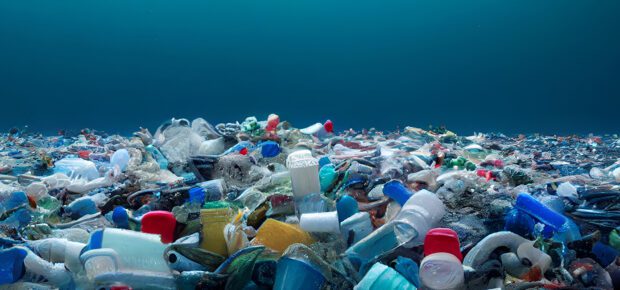January 28, 2025
Maybe you’ve seen the videos: an aquatic robot, in the ocean or a river, gobbling up enormous quantities of floating garbage.
They’re impressive. And so is the goal. Removing debris from the world’s water. In 2019 there were an estimated 5.25 trillion pieces of plastic litter in the ocean weighing more than 268,000 tons. But plastic isn’t the only material choking oceans and streams today. When all materials are taken into account, recent estimates say there may be more than 171 trillion pieces of trash floating in the ocean.
Small pieces of ocean trash could be eaten by marine animals. If they remain in the animal’s body, they could create a platform for infection or travel farther up the food chain as smaller animals are eaten by larger ones. Larger pieces of marine debris could impact shipping — about 10,000 shipping containers fall into the ocean each year.
Robots can help identify this debris and even remove it from the ocean, but there are limitations.
Patrolling Rivers
Deployment of garbage-eating aquabots is limited, mostly by a lack of funding, but there are a couple of prominent examples. First, there’s the Jellyfishbot, which IEEE Spectrum has called a “Roomba for Rivers.” Some local governments, like Long Beach in California, use them.
Another example is the River Interceptor, developed by the Dutch nonprofit The Ocean Cleanup. It stays anchored in the river. As garbage floats down the river, it is guided to the solar-powered bot’s mouth along a floating boom, and is then removed from the water with a conveyor belt.
These two bots have some differences. Jellyfishbot is relatively small; it would fit in the trunk of a car and is remote-controlled. The River Interceptor, on the other hand, is much larger, about twice as long and wide as a standard shipping container.
But both can help tackle a major problem: most of the trash in the ocean flows there from rivers. Which means that removing trash from those environments offers a bigger impact.
A Rapidly Improving Technology
Development of aquabots also faces some challenges. For one thing, not all garbage remains on the surface. Some sinks to the bottom, and some floats below the surface. And surface-dwelling robots can’t reach them.
Another challenge: visibility can be limited underwater. A robot operating below the surface may have trouble identifying marine debris. As a result, most prototypes for underwater garbage robots rely on human operators to identify garbage. There is, however, significant research into automatic, AI-based garbage identification methods. This article in IEEE Access provides an overview of research into that field, and shows a new method that increases accuracy.
“Most marine debris robotics projects are pilot projects. We need to sort out some of the core issues of marine debris to solve the problem of large-scale removal,” said IEEE Senior Member Wang Gang. “Most of the projects address surface litter, which is only one part of the debris. Most litter may be underwater, such as the fishing nets.”
Do We Need Aquabots to Clean the Ocean?
The amount of man-made debris in the oceans is staggering. And some estimates suggest that the volume of garbage could quadruple by 2040.
Robots, notes IEEE Member Paulo Drews, are expensive. They require maintenance, and operators. They also need somewhere to put the garbage.
“Using aquatic robots to deal with litter is an important direction for society,” Drews said. “Still, there are cost complexities to be considered as this technology improves. The robots can help, but humans need to reduce the amount of trash in the water bodies as soon as possible.”
Learn More: The ocean is vast, and so are the engineering activities. Check out these resources from IEEE TryEngineering to learn more about all of the opportunities found under the sea. And if you want to learn about the career path of an ocean engineer, check out this Q&A from the IEEE Oceanic Engineering Society.






 Meaningful Momentum or Running in Place?
Meaningful Momentum or Running in Place? AI Through Our Ages
AI Through Our Ages Liquid Infrastructure: Our Planet's Most Precious Resource
Liquid Infrastructure: Our Planet's Most Precious Resource The Impact of Technology in 2025
The Impact of Technology in 2025 Quantum and AI: Safeguards or Threats to Cybersecurity?
Quantum and AI: Safeguards or Threats to Cybersecurity? Why AI Can't Live Without Us
Why AI Can't Live Without Us Bits, Bytes, Buildings and Bridges: Digital-Driven Infrastructure
Bits, Bytes, Buildings and Bridges: Digital-Driven Infrastructure Impact of Technology in 2024
Impact of Technology in 2024 Emerging AI Cybersecurity Challenges and Solutions
Emerging AI Cybersecurity Challenges and Solutions The Skies are Unlimited
The Skies are Unlimited Smart Cities 2030: How Tech is Reshaping Urbanscapes
Smart Cities 2030: How Tech is Reshaping Urbanscapes Impact of Technology 2023
Impact of Technology 2023 Cybersecurity for Life-Changing Innovations
Cybersecurity for Life-Changing Innovations Smarter Wearables Healthier Life
Smarter Wearables Healthier Life Infrastructure In Motion
Infrastructure In Motion The Impact of Tech in 2022 and Beyond
The Impact of Tech in 2022 and Beyond Cybersecurity, Technology and Protecting Our World
Cybersecurity, Technology and Protecting Our World How Technology Helps us Understand Our Health and Wellness
How Technology Helps us Understand Our Health and Wellness The Resilience of Humanity
The Resilience of Humanity Harnessing and Sustaining our Natural Resources
Harnessing and Sustaining our Natural Resources Creating Healthy Spaces Through Technology
Creating Healthy Spaces Through Technology Exceptional Infrastructure Challenges, Technology and Humanity
Exceptional Infrastructure Challenges, Technology and Humanity The Global Impact of IEEE's 802 Standards
The Global Impact of IEEE's 802 Standards Scenes of our Cyber Lives: The Security Threats and Technology Solutions Protecting Us
Scenes of our Cyber Lives: The Security Threats and Technology Solutions Protecting Us How Millennial Parents are Embracing Health and Wellness Technologies for Their Generation Alpha Kids
How Millennial Parents are Embracing Health and Wellness Technologies for Their Generation Alpha Kids Space Exploration, Technology and Our Lives
Space Exploration, Technology and Our Lives Global Innovation and the Environment
Global Innovation and the Environment How Technology, Privacy and Security are Changing Each Other (And Us)
How Technology, Privacy and Security are Changing Each Other (And Us) Find us in booth 31506, LVCC South Hall 3 and experience the Technology Moon Walk
Find us in booth 31506, LVCC South Hall 3 and experience the Technology Moon Walk Virtual and Mixed Reality
Virtual and Mixed Reality How Robots are Improving our Health
How Robots are Improving our Health IEEE Experts and the Robots They are Teaching
IEEE Experts and the Robots They are Teaching See how millennial parents around the world see AI impacting the lives of their tech-infused offspring
See how millennial parents around the world see AI impacting the lives of their tech-infused offspring Take the journey from farm to table and learn how IoT will help us reach the rising demand for food production
Take the journey from farm to table and learn how IoT will help us reach the rising demand for food production Watch technical experts discuss the latest cyber threats
Watch technical experts discuss the latest cyber threats Explore how researchers, teachers, explorers, healthcare and medical professionals use immersive technologies
Explore how researchers, teachers, explorers, healthcare and medical professionals use immersive technologies Follow the timeline to see how Generation AI will be impacted by technology
Follow the timeline to see how Generation AI will be impacted by technology Learn how your IoT data can be used by experiencing a day in a connected life
Learn how your IoT data can be used by experiencing a day in a connected life Listen to technical experts discuss the biggest security threats today
Listen to technical experts discuss the biggest security threats today See how tech has influenced and evolved with the Games
See how tech has influenced and evolved with the Games Enter our virtual home to explore the IoT (Internet of Things) technologies
Enter our virtual home to explore the IoT (Internet of Things) technologies Explore an interactive map showcasing exciting innovations in robotics
Explore an interactive map showcasing exciting innovations in robotics Interactively explore A.I. in recent Hollywood movies
Interactively explore A.I. in recent Hollywood movies Get immersed in technologies that will improve patients' lives
Get immersed in technologies that will improve patients' lives